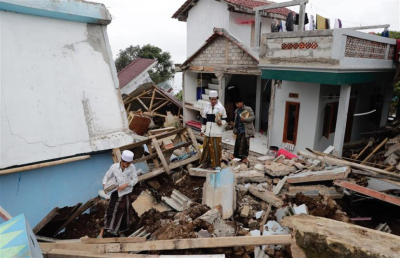TECHNO SPACE — Earthquakes are the most unpredictable natural disasters, yet they can change life on this planet. Earthquakes can occur on all continents of the world, but no person or equipment in this world can know when it will happen. Here are seven facts to know about earthquakes:
1. It happens 500,000 times a year
The United States Geological Survey (USGS) estimates that there are approximately 500,000 earthquakes each year. Many of these are found so deep in the earth’s crust that they cannot be detected without the use of a seismograph. Seismologists estimate that only about 20% of the world’s earthquakes are felt by humans, and about 100 of them cause damage.
Scroll to read
Scroll to read
2. ring of fire (ring of fire) is the hot zone of the seismic region
The area around the Pacific Ocean from New Zealand to South America is a hotbed of global seismic activity and is known as Fire ring. The USGS estimates that 90% of earthquakes occur in this region. Experts say the abundance of volcanoes and the constant movement of tectonic plates play a role in the activity.
The earthquake area extends from Java to Sumatra through the Himalayas, the Mediterranean and the Atlantic. This belt accounts for about 17% of the world’s largest earthquakes, including some of the most destructive.
3. Earthquake scale
Charles F. Richter developed the original earthquake scale in 1935. Over time, the technology improved, and researchers today use the moment magnitude scale to measure the size of an event.
There is no limit to how small or large the magnitude can be on the scale, but most graphs usually show a range from 0 to 10. Earthquakes with magnitudes below 2.0 may not be felt, but are the most common . Damage from an earthquake will not occur until it reaches a magnitude of 4.0 and above.
4. The largest earthquake recorded has a magnitude of 9.5
The USGS recorded the largest earthquake ever reported centered in Chile on May 22, 1960. It had a magnitude of 9.5 and was estimated to have killed more than 3,000 people. In Indonesia, the largest earthquake recorded was an earthquake measuring 9.1 on the Richter scale that occurred in Aceh in 2004. The earthquake followed by the tsunami claimed 227,898 lives.
5. Can change day length
Catastrophic earthquakes can shorten the duration of a day for the entire planet. NASA claims that large earthquakes can shift the Earth’s axis thus changing the length of the day. Changes in day length are invisible to the naked eye and are measured in microseconds or millionths of a second.
Scientists believe that the magnitude 9.1 earthquake in Aceh in 2004 shortened the length of the day by 6.8 microseconds.
6. Short shaking
The bigger the earthquake, the more likely it is that the ground will shake for longer. Since most earthquakes are small, the shaking lasts only a few seconds. In rare megaquakes, there is a chance that the shaking lasts a few minutes. Experts say the shaking you feel is over doesn’t mean the tectonic event is over.
Aftershocks can last for months or even years after the main event. The USGS said the aftershocks were caused by an adjustment process. In general, the larger the original earthquake, the more aftershocks there will be.
7. Unpredictability
No one can predict earthquakes. Experts say it’s because the mechanism that triggers the shaking happens deep underground in slow motion. But advances in science have provided better timing and maps of potential earthquakes so we can prepare for them.
Experts say early warning systems have continued to evolve in recent years. system like Shake alert detects the first waves triggered by shaking and can alert people before the arrival of more significant seismic waves. However, this alert only gives us a few seconds to prepare.
Due to this fact, earthquakes often become deadly disasters, such as Cianjur earthquake, West Java. As of Tuesday, October 29, 2022, the earthquake has claimed 327 lives.
Source:
– https://www.foxweather.com/learn/7-facts-about-earthquakes
– https://www.usgs.gov/programs/earthquake-hazards/earthquake-facts-earthquake-fantasy
“).attr( type: ‘text/javascript’, src: ‘https://platform.twitter.com/widgets.js’ ).prependTo(“head”); if ($(“.instagram-media “).length > 0) $(”


